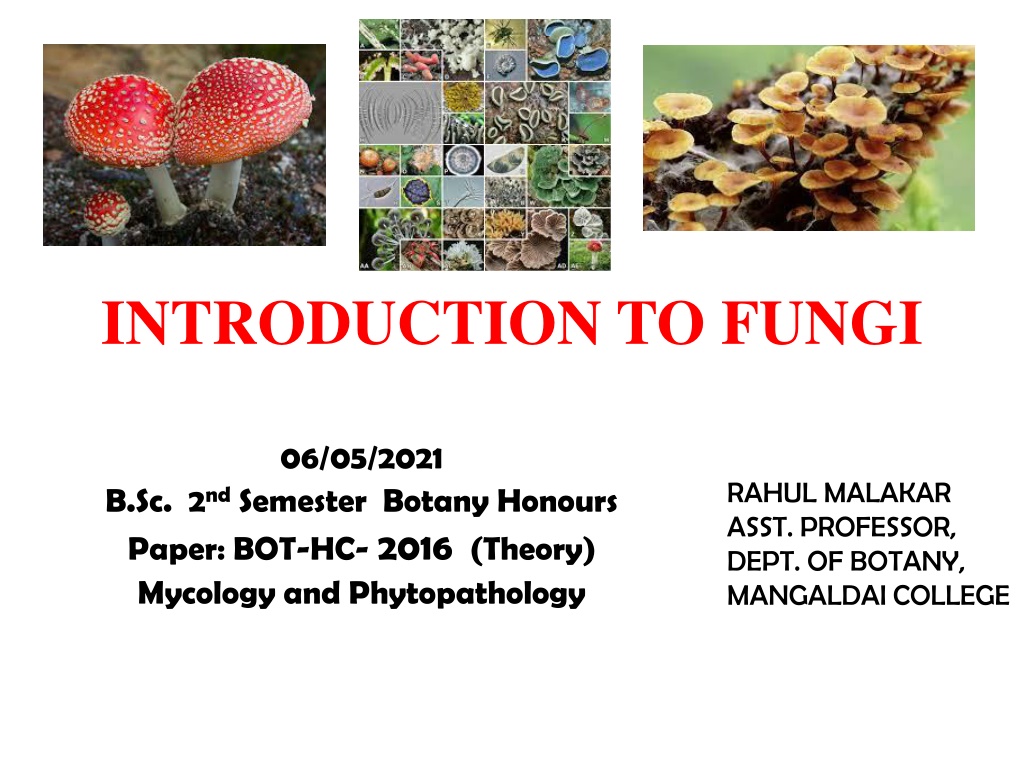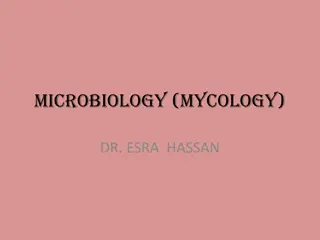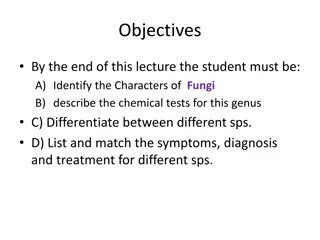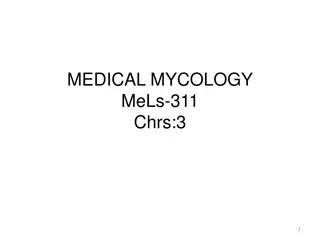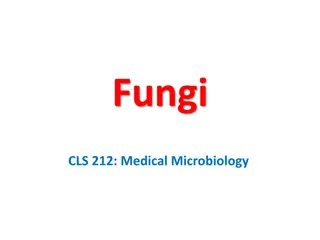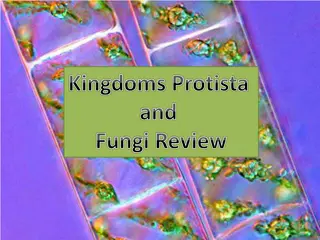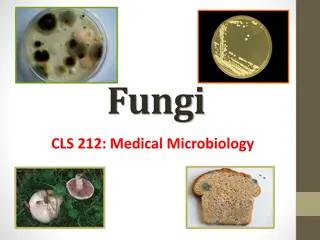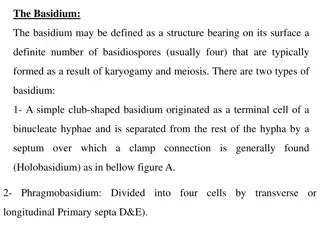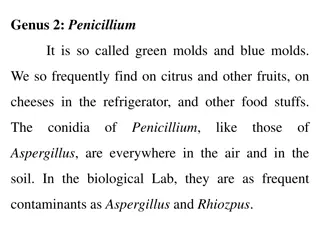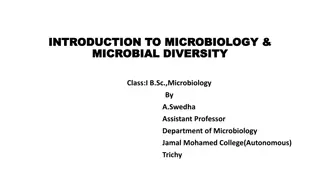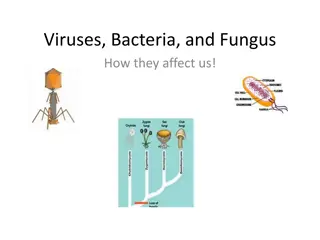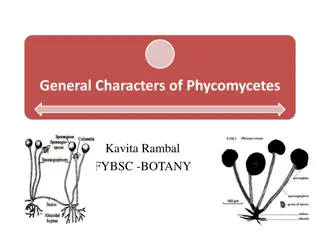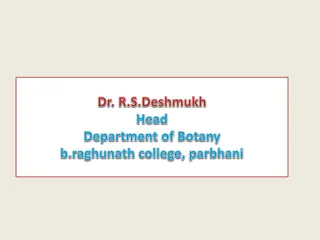General Characteristics of Fungi and Mycology Overview
Fungi, diverse eukaryotic organisms, exhibit various characteristics such as heterotrophic nature, distinct cell wall composition, and different modes of reproduction. Mycology, the study of fungi, delves into their classification and functions. Fungal cells may be unicellular or filamentous, with mycelium structures. Fungi show wide distribution and adaptation capabilities, with unique reproductive strategies. Mycologists like Pier Antonio Micheli and E.M. Fries have significantly contributed to this field.
Download Presentation

Please find below an Image/Link to download the presentation.
The content on the website is provided AS IS for your information and personal use only. It may not be sold, licensed, or shared on other websites without obtaining consent from the author. Download presentation by click this link. If you encounter any issues during the download, it is possible that the publisher has removed the file from their server.
E N D
Presentation Transcript
INTRODUCTION TO FUNGI 06/05/2021 RAHUL MALAKAR ASST. PROFESSOR, DEPT. OF BOTANY, MANGALDAI COLLEGE B.Sc. 2ndSemester Botany Honours Paper: BOT-HC- 2016 (Theory) Mycology and Phytopathology
INTRODUCTION Fungi, which is the plural form of Fungus ( Latin word Fungour- to flourish). Fungi are simple nonvascular, achlorophyllous , heterotrophic, spore bearing eukaryotes with a distinct cell wall made of fungus cellulose and chitin and having glycogen as reserve food. About 5100 genera and more than 50,000 species of fungi are known today. Mycology Study of fungi ( Mycologist- scientist who studies mainly about fungi) P.A. MICHELI Father of Mycology- Pier Antanio Micheli ( book: Nova Planterum Genera) Father of systematic mycology- E.M. Fries E.M. FRIES
General characteristics of fungi: 1. Fungi are cosmopolitan in distribution i.e., they can grow in any place where life is possible. 2. They are heterotrophic in nature due to the absence of chlorophyll. On the basis of their mode of nutrition, they may be parasite, saprophyte or symbionts. 3. The plant body may be unicellular (Synchytrium, Saccharomyces) or filamentous (Mucor, Aspergillus). The filament is known as hypha (plural, hyphae) and its entangled mass is known as mycelium. 4. The hypha may be aseptate i.e., coenocytic (without septa and containing many nuclei) or septate. The septate mycelium in its cell may contain only one (monokaryotic), two (dikaryotic) or more nuclei.
5. The septa between the cell may have different types of pores: micropore (Geotri- chum), simple pore (most of the Ascomycotina and Deuteromycotina) or dolipore (Basidiomycotina, except rusts and smuts). 6. The cells are surrounded by distinct cell wall (except slime molds), composed of fungal cellulose i.e., chitin; but in some lower fungi (members of Oomycetes), the cell wall is composed of cellulose or glucan. 7. The cells generally contain colourless protoplasm due to absence of chlorophyll, containing nucleus, mitochondria, endoplasmic reticulum, ribosomes, vesicle, microbodies, etc. 8. The cells are haploid, dikaryotic or diploid. The diploid phase is ephemeral (short-lived).
9. In lower fungi like Mastigomycotina, the reproductive cells (zoospores and gametes) may be uni- or biflagellate, having whiplash and/or tinsel type of flagella. But in higher fungi like Zygomycotina, Ascomycotina, Basidiomycotina and Deuteromycotina, motile cells never form at any stage. 10. In response to functional need, the fungal mycelia are modified into different types such as: Plectenchyma, Stroma, Rhizo- morph, Sclerotium, Hyphal trap, Appreso- rium, Haustorium, etc. 11. The unicellular fungi, where entire plant body becomes converted into reproductive unit, are known as holocarpic fungi (e.g., Synchytrium). However, in many others, only a part of the mycelial plant body is converted into reproductive unit, thus they are called eucarpic fungi (e.g., Pythium, Phytophthora). 12. They reproduce by three means: Vegetative, asexual and sexual. (a) Vegetative reproduction takes place by fragmentation (Mucor, Penicillium, Fusarium), budding (Saccharomyces, Ustilago) and fission (Saccharomyces). (b) Asexual reproduction takes place by different types of spores. These are zoospores (Synchytrium), conidia (Pythium, Aspergillus), oidia (Rhizopus), chlamydospore (Fusarium), etc. The spores may be unicellular (Aspergillus) or multicellular (Alternaria).
Status of fungi in living system Tens of thousands of organisms, from mushrooms to mold to yeast, fall under the umbrella of fungi. Once thought simply to be plants, fungi have emerged as their own taxonomic kingdom. The various fungal species are diverse, with many unique properties: some innocuous, some useful and some harmful. It has taken decades, as technology improved and scientific knowledge evolved, to appropriately classify this myriad group of organisms.
As recently as the 1960s, fungi were considered plants. In fact, at that time all organisms were classified into only two groups or kingdoms: plants and animals. In a 1969 article published in the journal Science, ecologist Robert Whittaker explained the basis of this two-kingdom system. For many decades in history, the only living creatures humans observed around them were either the "rooted" plants that produced their own food, or motile animals that sought out their food. Thus mobility and the method of gaining nourishment became the criteria for a system of classification. "The animals moved and plants didn't, and that's how fungi got stuck with the plants," said Tom Volk, a professor of botany at the University of Wisconsin-La Crosse.
However, unlike plants, fungi do not contain the green pigment chlorophyll and therefore are incapable of photosynthesis. That is, they cannot generate their own food carbohydrates by using energy from light. This makes them more like animals in terms of their food habits. Fungi need to absorb nutrition from organic substances: compounds that contain carbon, like carbohydrates, fats, or proteins. Based on these and other properties, in 1969 Whittaker proposed that fungi become a separate kingdom as a part of a new five-kingdom system of classification. The proposed classification included a vast array of species. Among them, mushrooms, yeast, molds, slime molds, water molds, puffballs and mildews. Since then, the system of classification and the fungal kingdom have been further refined. For example, slime molds and water molds were shuttled off to a different kingdom. Today, the members of the kingdom Fungi are also known as the "true fungi."
Habits or modes of life Heterotrophs and mode of nutrition is heterotrophic. Depend on the mode of nutrition, fungi are classified into- a) Saprophytes or Saprobes(grow on dead organic matters). Saprophytic fungi e.g. molds, mushrooms, yeast, Penicillium, Mucor etc. b) Parasites( live in or on the living bodies of other organisms). Parasitic fungi e.g. rust, smuts etc.. parasitic fungi feed on host suscept. They may be: I. Ectoparasites (e.g. vine molds) II. Endoparasites (e.g. Pythium debaryanum, Ustilago etc.) Penicillium Pythium debaryanum
Fungi can also be classified as- 1. Obligate parasites(grow only upon suitable living host tissues e.g. downy and powdery mildews) 2. Facultative saprophytes (normally parasitic but at emergent conditions may act as saprophytes e.g. Phytophthora infestans) 3. Facultative parasites(normally saprophyte but at emergent conditions may act as parasites e.g. Botrytis cinerea ) 4. Obligate Saprophytes(strictly saprophytic e.g. Mucor) powdery mildews . Phytophthora infestans Botrytis cinerea Mucor According to damage done to the host plant-Destructive Parasites and Balanced Parasites
Thallus organization: The vegetative phase of a fungus is a thallus. It may be unicellular or filamentous. a) Unicellular Thallus: In some lower fungi, the thallus is more or less a spherical, single-celled structure. At the time of reproduction, it becomes a reproductive unit which produces asexual or sexual cells. Such fungi are called holocarpic fungi. e.g. Yeast, Plasmodiphora etc. Yeast Plasmodiphora
b) Filamentous Thallus: Majority of fungi have filamentous thallus. It originates through the germination of a spore. In some species, the spore on germination, produces only a short, tubular structure of limited growth called hypha. When spores of fungi produce many such kind of long, fine filaments they are called hyphae. Some of these hyphae at a certain stage of maturity, extend into the air and bear the reproductive bodies and rest spread over or within the substratum and continue the normal activities. Such fungi are called eucarpic.
Collectively the hyphae comprise the vegetative body(thallus)of a fungus which is called themycelium. The mycelium is a food procuring structure in the fungal life cycle. They carry on the general activity of a plant cell except photosynthesis Kinds of Mycelia : A.Aseptate Mycelium- Mycelia of some fungi lacks internal partitions of any kind . The hyphae are thus multinucleate and aseptate. The aseptate, multinucleate mycelium is called coenocytic . E.g. Mycelia of Phycomycetes.
B. Septate Mycelium- Mycelia of Ascomycetes and Basidiomycetes develop internal cress walls called the septa which divide the hyphae into segments. Septa appear at regular intervals behind the hyphal tip. The segments may be uninucleate or multinucleate. In a septate mycelium, the septa between the cells are transverse. Septa in septate mycelium are incomplete. Each has a central pore and rarely more than one pore.
